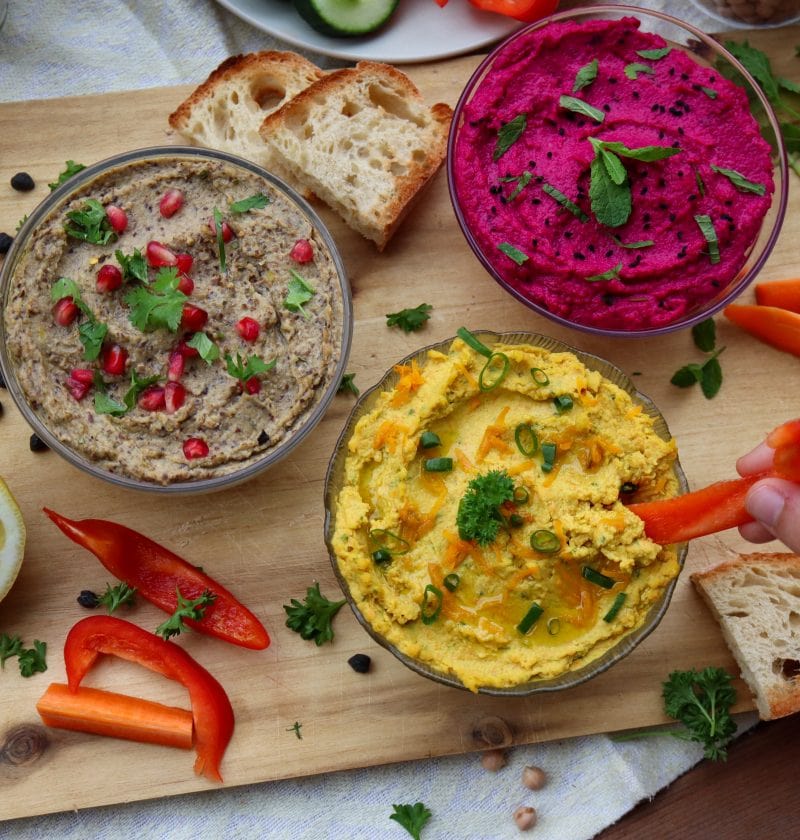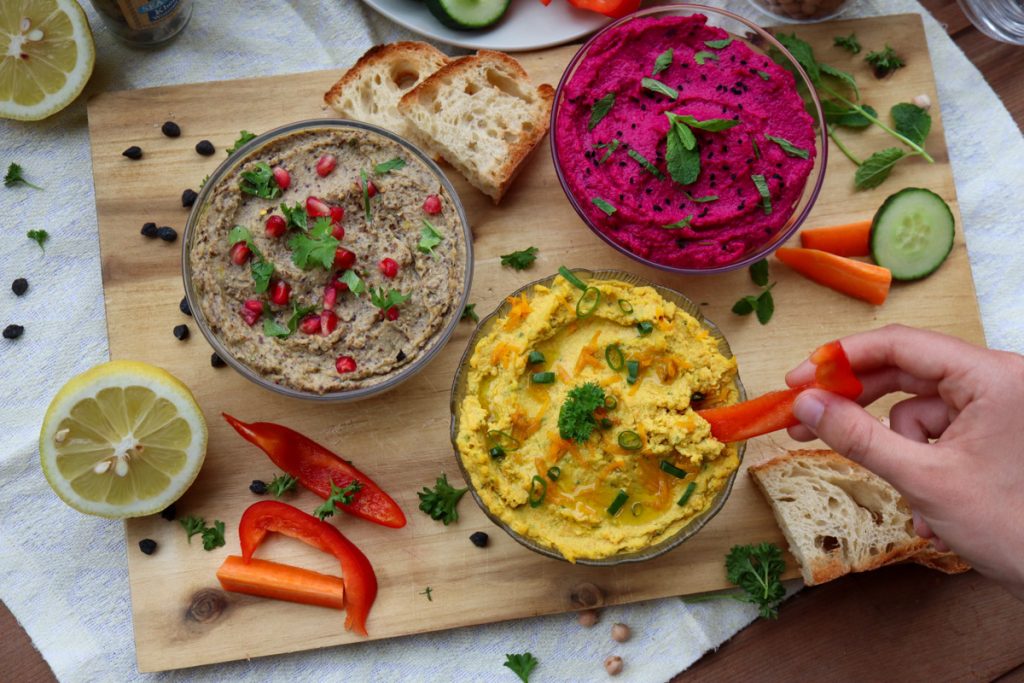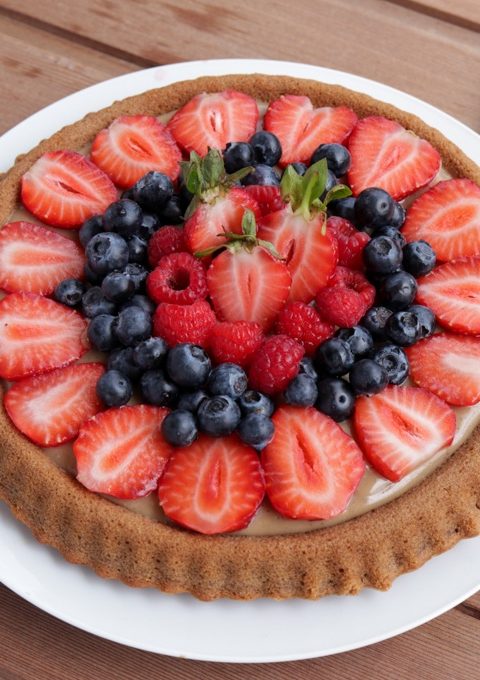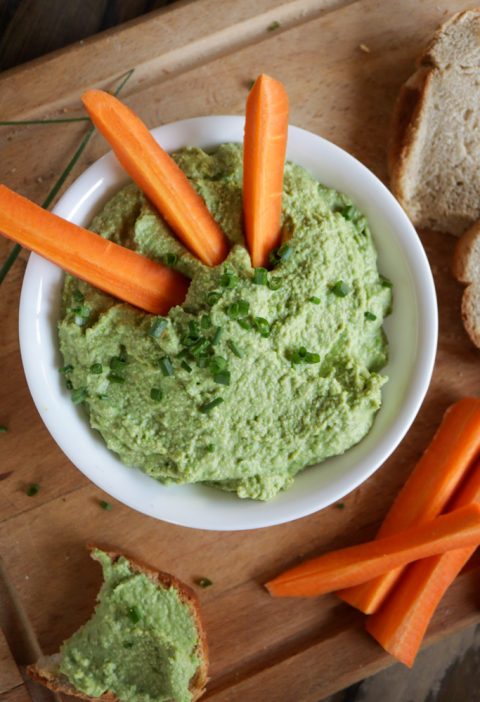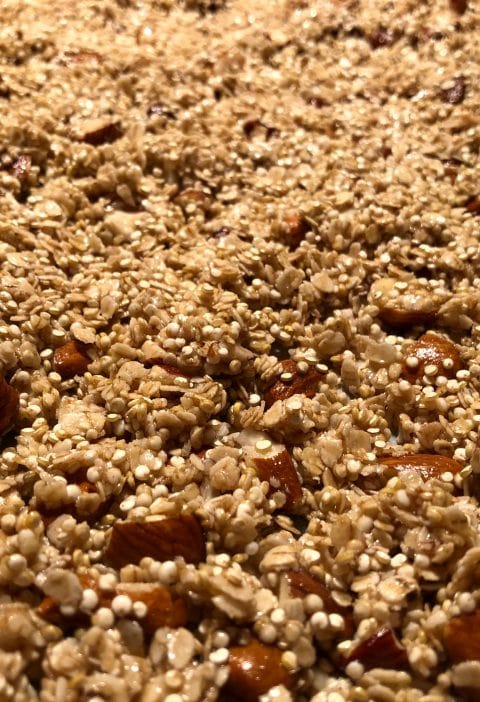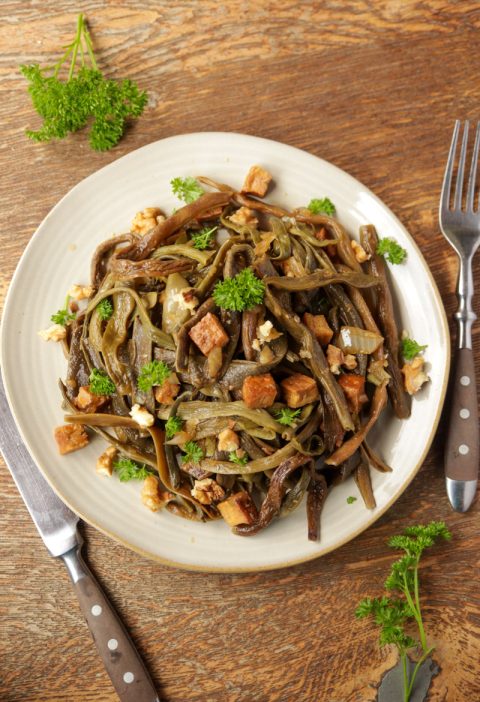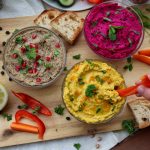Hummus, the yummy, creamy dip from the Middle East is always a welcomed dish. As you know, the best one is the home-made one, hence I have prepared a trio! All of them are uncomplicated in their preparation and bring color to each table. At home or for a party, this vegan trio is always a winner!
A bit about hummus
Chickpeas are the base of each hummus. You probably have already eaten this classic oriental dish as a dip together with raw vegetables or falafel. Hummus is also tasty as a vegan spread, with potatoes, as a takeaway snack and for sure a welcome bring-along to a party. Chickpeas are a rich source of fibre, vitamins and minerals and, together with other wholesome ingredients, make hummus a truly healthy dish.
The start of each hummus, the slow one and the fast one.
Each hummus recipe starts with chickpeas and soaking. This is best done overnight or at least for 8 hours. Chickpeas need to absorb a lot of water over many hours. Discard the soaking water to get rid of any residue. Rinse the chickpeas carefully and you can start cooking. If you are in a hurry, chickpeas in a glass or in a can save time and you can save the soaking, rinsing and cooking steps.
Following the Don’t Waste Principle, you can re-use the cooking water as aquafaba. Check below for more information.
Number one: Beetroot with mint hummus
What a pop of color! It is not only the looks but the slightly sweet taste of the beetroot and the refreshing mint that make this hummus so special. With the strength of your food processor or your mixer, the smooth consistency will add its part to a truly yummy hummus.
In the recipe, I split the chickpeas between the beetroot hummus with mint and the carrot hummus with turmeric. Of course, you can also just make a large portion of the beetroot and mint hummus or just cook half the chickpeas. Hummus is a great storage item and will keep in a sealed jar in the fridge for 5-7 days.
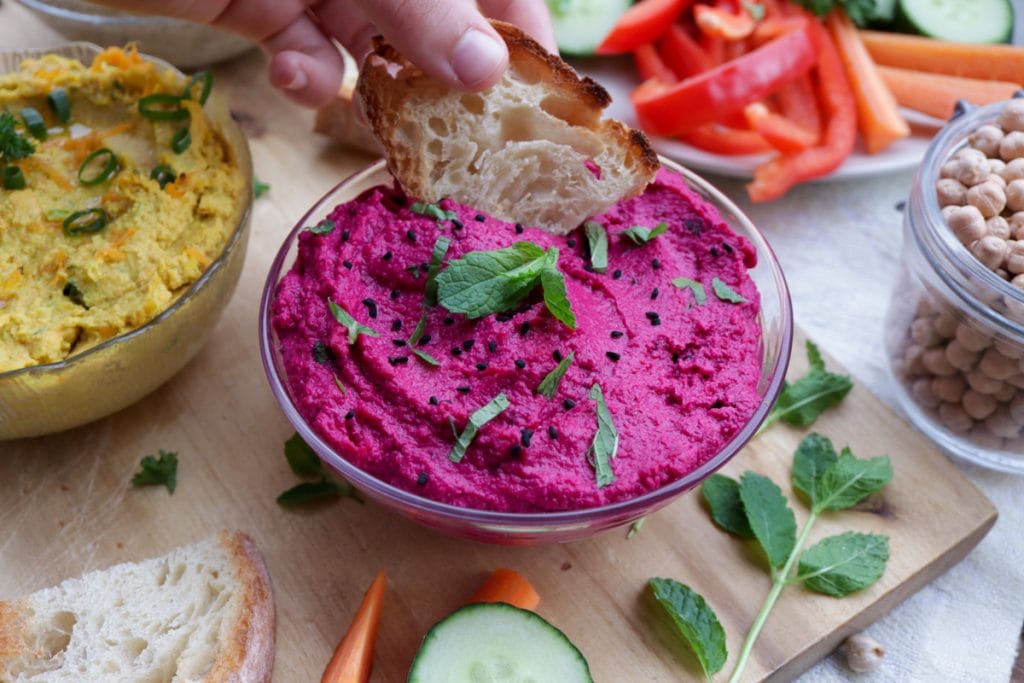
Number two: Carrot with turmeric hummus
Carrots give this vegan hummus a slightly sweet taste, turmeric gives its great yellow color and the spice za’ata finishes with an oriental nuance. Looks is a lot, but not everything; but Turmeric definitely adds to the wholesome outcome. The so-called cherry on the top is the velvety consistency of this oriental hummus version.
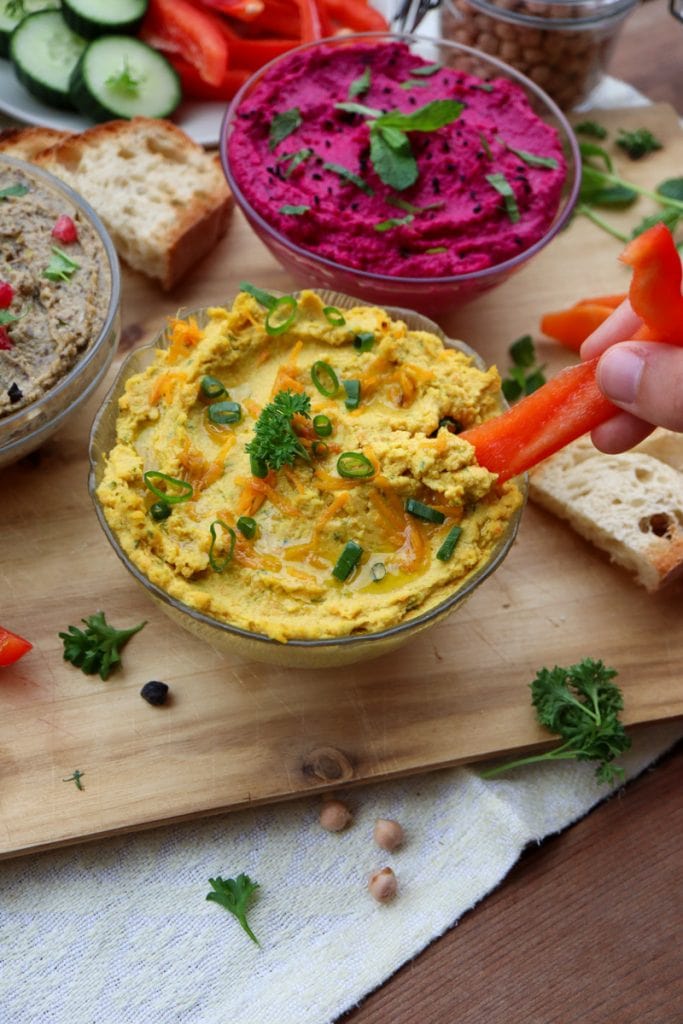
Number three: Black chickpea with seaweed hummus
Black chickpeas are definitely less known than white chickpeas. Both look exactly the same inside, but one has a black skin. Black chickpeas taste nuttier than white ones and give this hummus a very special kick. You also have to soak black chickpeas overnight.
I use seaweed salt in my recipe. If you don’t have any, seaweed flakes work great. I love to use them regularly as a healthy ingredient. The creaminess is the same story as with the other hummus – your food processor or mixer will take care of this. In the end, I used some coriander and some pomegranate seeds for decoration.
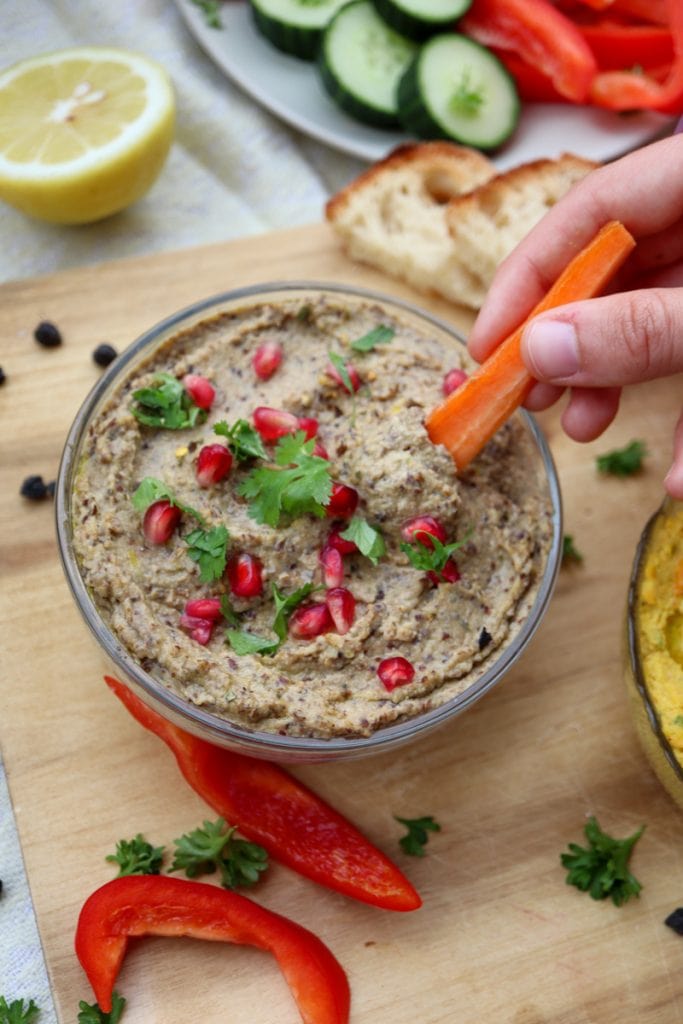
My don’t waste tip for your chickpea cooking water:
The cooking water for the chickpeas is called aquafaba. You can whip it like egg white, hence it is an ideal plant-based substitute for beaten egg white. If it’s too runny, just let it simmer uncovered until you get a slightly gel-like consistency. After cooling down, you can use the aquafaba for vegan mousse au chocolate or meringue, for example.
Should you be on a roll of dip preparation: Check my recipe for vegan tzatziki!

A Trio of Hummus
Ingredients
Basic recipe with the white (not black) chickpeas for the beetroot with mint and the carrot with turmeric hummus
- 200 g chickpeas, white results in about 400 g cooked chickpeas
- 70 g Tahini
- 3 garlic cloves
- 3 tsp cumin seeds crush in a mortar
- 5 Tbsp lemon juice freshly juiced
- 8 Tbsp olive oil
- 10 Tbsp water
Additionally for the beetrot with mint hummus
- 1/2 of the white chickpeas
- 2 raw beetrot, small ones about 110 gramm
- 10 g mint leaves finely chopped
Additionally for the carrot with turmeric hummus
- 1/2 of the white chickpeas
- 1 Tbsp olive oil
- 2 small spring onions approx. 60 g, cut in small rings
- 1 piece root of turmeric approx. 5 g (about thumb width), finely grated
- 1 carrot approx. 100 g, finely grated
- 3 Tbsp water
- 3 tsp black pepper
- 3 tsp Za’atar
Black chickpea with seaweed hummus
- 200 g black chickpeas
- 35 g Tahini
- 1-2 gloves of garlic
- 1 tsp cumin seeds crush in a mortar
- 2-3 Tbsp lemon juice freshly juiced
- 4 Tbsp olive oil
- 4 Tbsp water
- 2 tsp lemon zest
- 1 tsp roasted sesame oil
- approx. 1/2 tsp seaweed salt oder seaweed flakes to taste
Instructions
- Soak the light and, if you want to prepare all 3 hummus variants, the black chickpeas separately in large bowls covered with plenty of water overnight or for at least 8 hours.
- After the soaking time, boil the well-rinsed chickpeas in two separate, large saucepans in plenty of water for at least 90 minutes. Drain off the cooking water or save for aquafaba (see tips).
- Beetroot hummus: At the same time, cook the beetroot in plenty of water for 1 hour, then peel.
- For the white chickpea base, put the cooked and slightly cooled chickpeas in a food processor (alternatively hand blender). Add all the remaining ingredients for the base and puree until smooth. If necessary, scrape the hummus off the sides of the food processor and puree again (add a little more water depending on the desired consistency). Take out half of the white chickpea base and set aside.
- For the carrot with turmeric hummus, cut the spring onions into fine rings, finely grate the carrot and turmeric. Heat the olive oil in a coated pan. Fry the spring onion rings in it for 1 minute, then add the grated turmeric root and the finely grated carrot and fry for 1 minute. Put the contents of the pan, 3 tablespoons of water and the za'atar in the food processor (alternatively hand blender) to half of the light base. Mix again and season with black pepper, salt and, if necessary, a little lemon juice and pour into a bowl.
- For the beetroot with mint hummus, place the second half of the white chickpea base in the food processor and puree with the peeled, cooked beetroot. Add the chopped peppermint leaves and mix well. Season with pepper, salt and a little lemon juice if necessary and pour into a bowl.
- For the black seaweed hummus, put the cooked black chickpeas and the remaining ingredients in a food processor (alternatively hand blender) and puree finely. If necessary, scrape the hummus from the sides of the food processor after 2 minutes and puree again (add a little more water depending on the desired consistency). Season with a little more seaweed salt or seaweed flakes, pepper, salt and, if necessary, a little more lemon juice. Pour into a bowl.
- Arrange your hummis beautifully and decorate with e.g. fresh parsley, coriander, chives, mint or pomegranate seeds. Serve together with (pita) bread, crackers, vegetable sticks etc.
